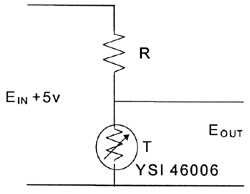 |
 |

 |
 |
| ||||
 | ||||
|
| ||||
| ||||
|
Calculating Self-Heat Self-heating occurs when the power applied to the thermistor is greater than what the thermistor can dissipate. This causes the thermistor to "heat up" and change resistance. To calculate self-heat for a thermistor, you need the following information: 1. R vs. T curve for the thermistor you are using. 2. Dissipation constant (the amount of power it takes a thermistor to raise 1șC). Be sure to note whether the dissipation constant is for still air or stirred oil bath. 3. Applied voltage. We will determine the self-heat for the circuit below. The thermistor, T, is a YSI 46006, 10k Ohms ±0.2șC (0 to 70șC), glass thermistor. We are operating over a temperature range of 0 to 100șC. The dissipation constant for this thermistor is 4mW/șC in still air. The divider resistor R is 10k Ohms and EIN is +5 volts.  The R vs. T curve for thermistor T is:
First, we use Ohm's Law (E=I * R) to determine voltage drop across the thermistor.
Next, determine the power applied to the thermistor using equation, P=E2/R. At this point, we check to be sure that we are not exceeding the power rating for the thermistor. The YSI 46006 is rated for a maximum power of 50mW/șC derated to 2mW/șC @ 125șC.
Now that we know the power applied to the thermistor, PT, we can use the dissipation constant (DC) to figure self-heat: Self-heat = PT / DC
The maximum thermistor error is the tolerance plus self-heat error.
Call YSI for help with your thermistor applications. The YSI Temperature call center is 800-747-5367 or 937-427-1231. YSI Technical Note TP-TN017 |
|||||||||||||||||||||||||||||||||||||||||||||||||||||||||||||||||||||||||||||||||||||||||||||||||||||||||||||||||||||
| ||||||||||||||||||||||||||||||||||||||||||||||||||||||||||||||||||||||||||||||||||||||||||||||||||||||||||||||||||||||